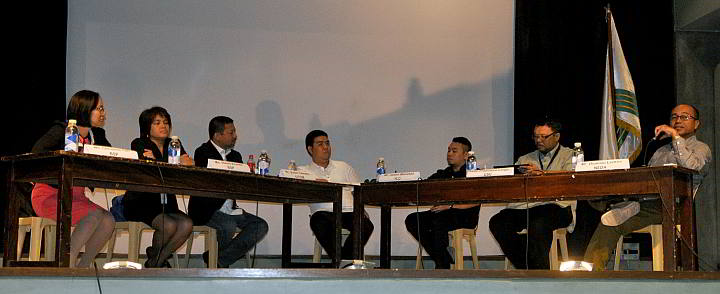
Dionisio Ledres, (far right) National Economic Development Authority Region 7 chief economic development specialist, leads the Sustainable Cebu forum panel at the University of San Carlos. Other panelists include Christine Tan, Bangko Sentral ng Pilipinas representative (left) and Victor Caindec, City Traffic Operations Management executive director (3rd from left).
(CDN PHOTO/CHRISTIAN MANINGO)
Cebu is expected to thrive in the advent of the 2015 Asean Economic Integration and in the next 10 years, an official of the National Economic and Development Authority (Neda) said on Friday.
Dionisio Ledres, assistant regional director of Neda in Central Visayas, said Cebu is ready to take advantage of the opportunities the integration will bring.
“I think we have a very high chance of making money in the Asean integration,” he said, addressing a panel during a discussion on a Sustainable Cebu last Jan. 30 at the Buttenbruch Hall of the University of San Carlos.
The forum aimed to shed light on the different issues of growth and development of Cebu especially in the face of Asean integration.
Ledres said that Cebu will be dominant in the next decade since most of the output produced by Region VII comes from the province.
Bigger markets will be opened in the integration, he said.
Ledres said that there are many “bright” entrepreneurs in Cebu who can compete in the Asean market.
“With that comes our ability to adjust and take advantage of the competition,” he said.
Another good thing about the integration is the practice of profession.
Ledres said that engineers, architects, designers, and economists, among others, will become even more recognized in neighbor nations.
Despite this prediction, the official said that Neda and other government agencies are still “doing their homework.”
He said they are closely working together with the Chambers of Commerce and the Department of Trade and Industry to address how small and medium enterprises (SME) can cope and take advantage of the opportunities brought about by the integration.
According to Neda, Central Visayas is one of the fastest growing economies in the country. Among the different cities in the region, Cebu is one of those leading in this particular phenomenon.
Despite this growth, there have been a lot of challenges especially in the areas of traffic congestion, crime, pollution and poverty.
Traffic
Citom Executive Director Victor Caindec, who was one of the forum panelists, said that he welcomes traffic since it is a sign that people are coming into the city and commerce is happening.
“Slow moving traffic is a problem… I want traffic to be good. I want vehicles to be on the road. We want people to move fast from where they’re coming from to their destinations. But we don’t want for traffic to be slow moving in a way that it hampers economic activity,” he said.